 France (1881-90) – France’s ‘Grand Hotel’
France (1881-90) – France’s ‘Grand Hotel’WW1 French Battleships:
Duperre class | Terrible class | Amiral Baudin class | Hoche | Marceau class | Charles Martel class (1891) | Charlemagne class | Henri IV | Iena | Suffren | Republique class | Liberté class | Danton class | Courbet class | Bretagne class | Normandie class | Lyon classThe Hoche is now as then, the supreme ugly ducking in the nest, a testimony of how hard naval engineers of the time tried to push their luck with designs that had to square circles in terms of iron construction, heavy weaponry, stability as a gun platform, seaworthiness, and optimal protection, both active and passive.
The Hoche also incarnates with vivid colors the aberrations of the “Young School” naval think tank of young officers and engineers that imposed its views to the ministers of the 1880-1910 decades. They were firm believers in the most modern technologies as a way to compensate for the French Navy inferiority (towards the Royal Navy) through many innovations, almost rejecting the concept of capital ships battle lines. But the experimental nature of it all plagued the French Navy in many ways, generating extreme heterogeneity, odd solutions not repeated elsewhere, and excessive construction delays caused by too many revisions due to political instability.
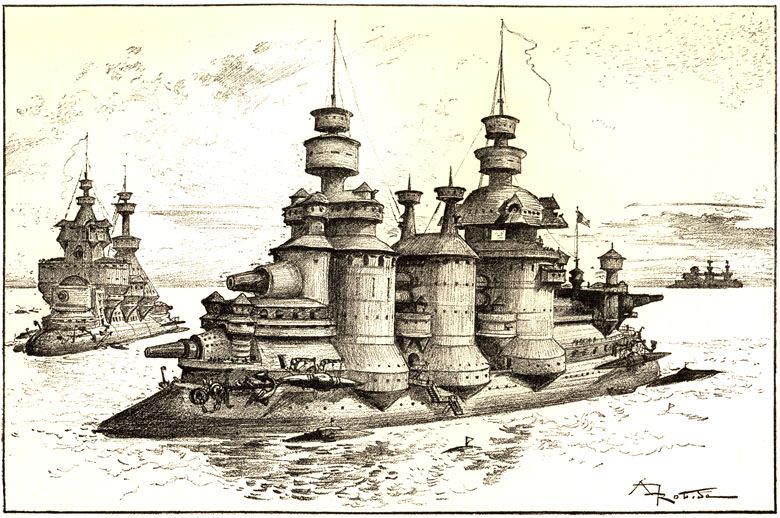
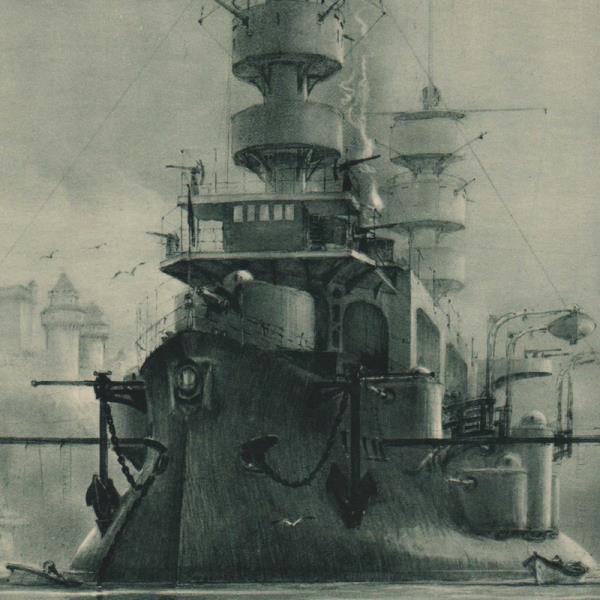
Nothing encapsulates more the unique, almost “medieval” look of French battleships in the 1880-90s decade. Top: “Le Mastodonte”, engraving of the Charles Martel, giving some impression of the prow of the Hoche, Baudin and other ships of the time with their pear-shaped hull and numerous turrets and barbettes in rhomboidal position. Bottom: Illustration of French futurist illustrator and caricaturist Albert Robida (1848-1826).
This state of affairs stopped in 1912 when a new dynamic naval minister and admiral tried to reverse this, Boué de Lapeyrière. But when the war broke out barely two years later, the naval plan was just started. France entered the war with a woefully inadequate fleet made of obsolescent and relatively strange vessels. The Hoche, fortunately discarded a few years before, was one of the most shining example of this. Nicknamed the “Grand Hotel” the Hoche was indeed plagued, notably by massive stability issues. The Kaiser, Wilhelm II seeing her during a naval parade in Kiel was heard declaring “what a splendid target”…
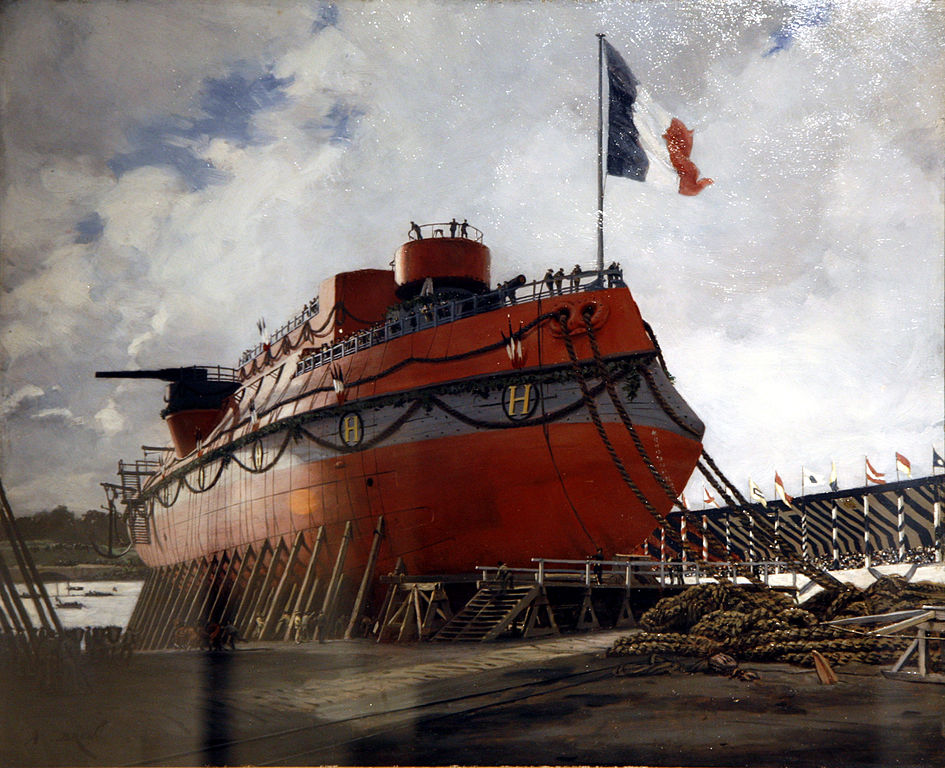
Painting of the launch of Hoche in 1886 – wikimedia cc
Genesis of French 1880s Battleships
A long way has been done since the revolutionary Gloire in 1859. France had managed to crank up 23 masted ironclads since, including impressive steel ship, the latest being the massive Courbet class central battery ironclads, launched 1879-82. They were also the last of their kind. The 1879 Admiral Duperré was a barbette ship, follwowed by the steam-only barbette ironclads of the Terrible class (1885) and Admiral Baudin class (1883). The Hoche became a transitional model, basically an hybrid turret/barbette ironclad.
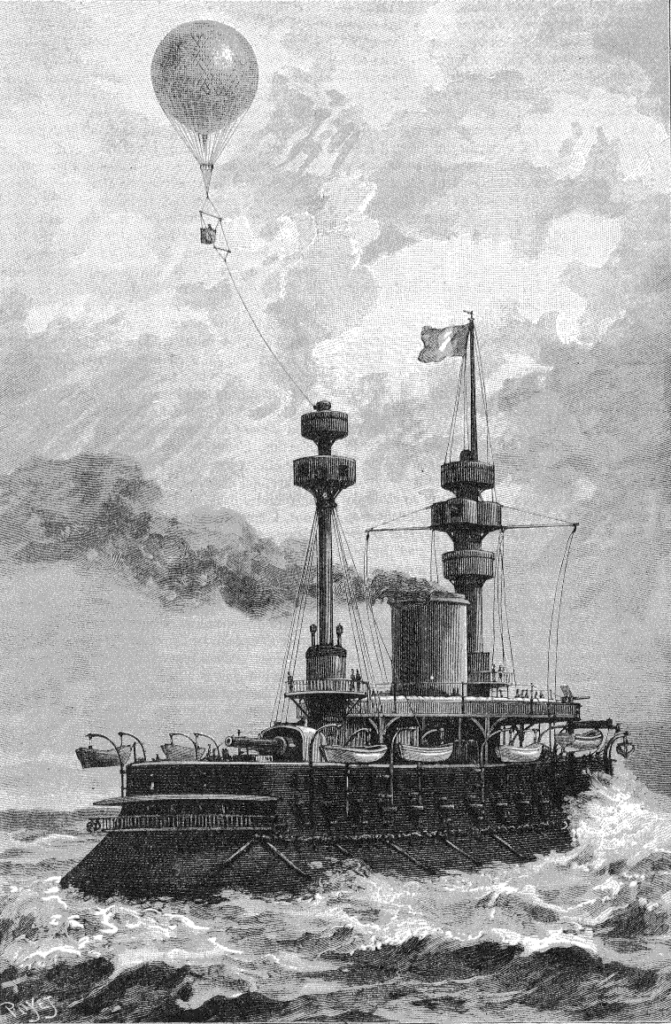
Engraving of the Formidable testing a captive balloon in 1890. By Louis Poyer, Source: La Nature. Revue des sciences et de leurs applications aux arts et à l’industrie, pp. 312-314. From Le Conservatoire numérique des Arts & Métiers
About the Baudin class: The precedessor of Hoche, Amiral Baudin and Formidable, has been laid down at Brest and Lorient respectively in 1879. They were an evolution of the Duperré (laid down in 1877) more than the Terrible class which was more a coastal ironclad class. Displacing 11,720 tons standard, the Baudin were signalled by their high freeboard, and looked modern with their massive guns, 14.6 in (355 mm) from Creusot and St. Chamond, all three in a centerline, with one midships. As usual they featured heavy military masts with armoured tops for light artillery and spotting, and some variety in their secondary armament (four 6.4 in, eight or ten 5.5 in, 3-pdr, and 1-pdr QF guns). Both ships diverged in light artillery. Construction time was quite long, as they were completed in 1888-89 after ten years. Their armour was conventional but faulty at a crucial juncture: There was a large area of unprotected side above the waterline, a silver plate offer to plunging hits. Their modern artillery configuration, inline, was not repeated as the admiralty wanted their four guns, and the lozenge configuration was later adopted.
The Hoche was in fact initially planned as the third unit of the Amiral Baudin class. However its design was heavily modified to the point of generating a very specific ship. This was very typical of that mood of “prototyping frenzy” of the time. Although the Amiral Duperré and Baudin classes made a sufficient impression at the time of their appearance, they were never considered completely successful, their main drawback being the unprotected areas and high freeboard and narrow armor belt, which covered the ship only at the waterline. For the next design plunging fire was taken more seriously, as holed just above the waterline would surely flood the armored deck surface, and as compartmentation and bulkheads were an afterthought waves would sweep above the belt, leading to a rapid loss of stability and danger of capsizing in case of excess manoeuvres.
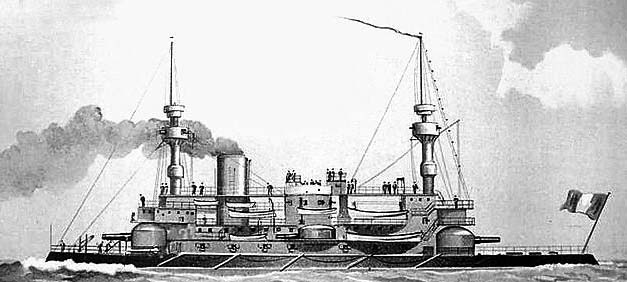
French battleship Hoche, Mitchell’s painting (cc)
Since the integrity of the whole waterline area, including well above was considered by the French admirals as a priority, both to maintain full speed and staying an acceptable gun platform, engineers saw only way to resolve the issue in reducing the freeboard height. Naval Engineers thought capable of designing low freeboard ships while preserving acceptable seaworthiness and the same speed. The culprit were the second class coastal battleships of the Terrible class. This drove the contracted yard to simply make it larger.
The new type of project was developed on the initiative of marine engineer Charles Ernst Ewen, the chief designer for armored vessels of the French fleet, from 1880 to 1897. Armament was discussed also a large deal, after protection. At first, 406 mm guns were planned, even 450 mm guns, which rivalled those of the Italian ironclads of the time, but more reasonable concepts prevailed, leading to the adoption of the more standard 340 mm. During the design process, blueprints underwent significant revisions due frequent change of naval ministers, each having its own views on current developments. Therefore final blueprints was approved only four months after the order was passed.
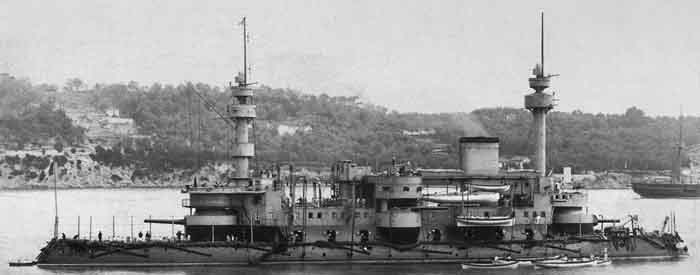
Design of Hoche
As already stated, the battleship as drawn by Chief Engineer Huin was marked by having a relatively low freeboard, fully protected by armor. However this also meant that some facilities and crew accomodations in the former upper level of the hull should be moved somewhere else. It was decided to transfer them to superstructures, which by consequence appeared massively expanded, giving the ship its iconic appearance. Also the funnel was pushed forward. Huin submitted two different plans, but he could have never predicted the numbers of changes that will plague her construction afterwards.
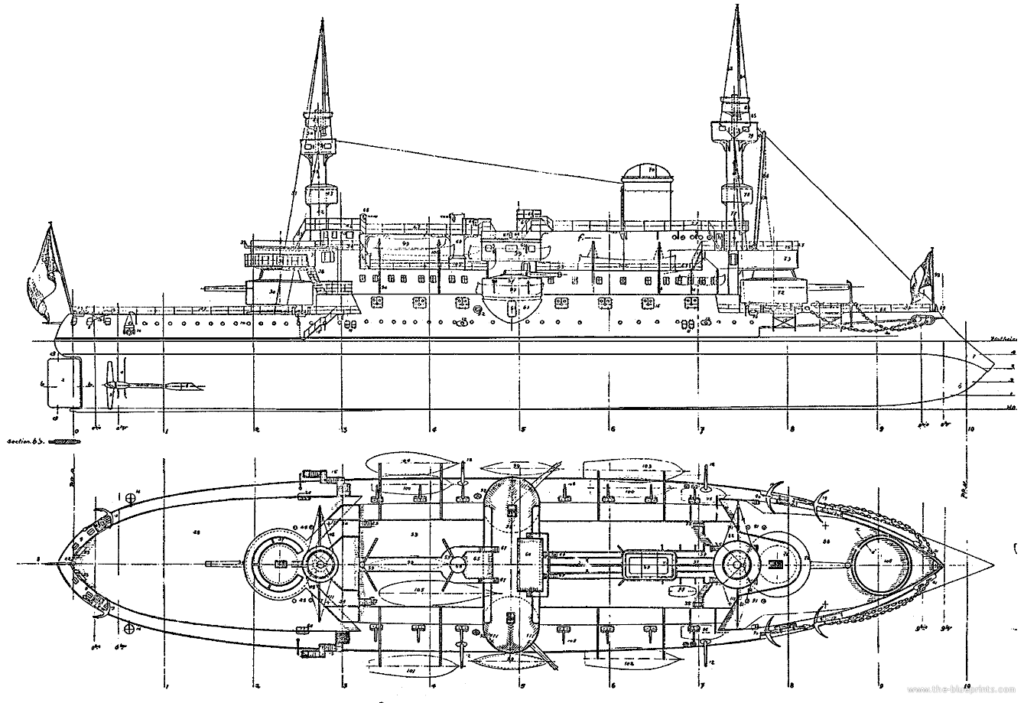
Original blueprint (extract) of the side and top view of the Hoche as approved in 1882 (Archives – Marine Nationale)
The silhouette was also marked by two massive armored masts with heavy multi-tiered closed tops, making turret-like structured which took place in the superstructure, also carrying the weight of the extra bridges. The military tops also allowed the admiral to better control the battle. Of course their main purpose outside observation and communication was to place light QF artillery, to deal with TBs. The high position gave them an excellent sector of fire. However, another point somewhat missed by engineers (or forced upon by the Navy) was the combination of well developed, high superstructures and heavy combat masts caused the center of gravity to move up significantly.
The Hoche, as designed, displaced about 11,502 tons but was still slightly smaller than previous ships. Total by 1891, amounted to 19.583 million francs, still below the average standard of the time, another subject to be proud of by the Yard. Nevertheless due to the chaotic nature of French political life, constant budgetary problems and constant interferences caused the construction drag for 9 years, compared to 4 years on average of the British battleship. The main issue was that in five years, naval tech advanced so rapidly as to render the Hoche obsolete. The new battleship was named after Lazare Hoche, a French Revolution General.
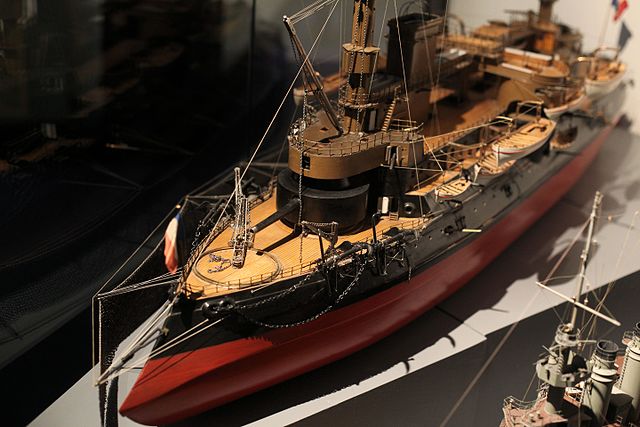
Model of the Hoche showing the forward ‘turret-barbette’ – Musée de la Marine, Paris
Armament of the Hoche
Main and main-secondary armament
Initially, the French naval staff wanted four 14.6 in (340 mm) guns, installed in a lozenge pattern barbettes. But in August 17, 1882, as construction was well advance, the new naval minister, Admiral Clouet, proposed to the replace the fore and aft barbettes installations by rotating armored towers, considered less vulnerable. For reasons of weight saving however, and already to preserve the center of gravity the project was modified to leave only two 340 mm guns fore and aft in hybrid installations, of quite unique turret-barbettes. The lack of firepower would be compensated by installing smaller, but faster guns in other positions.
As a result, the final battleship armament consisted of two 14.5 in (340 mm)/28-caliber rifled guns, completed by two 274 mm/28-caliber rifled guns in lateral barbettes, preserving the initial lozenge pattern so distinctive of French ironclads. The management of two different calibers make the whole main artillery spotting and control more difficult as observers had a hard time distinguishing between their respective plumes. However the naval staff considered this small matter due to the short firing distances of that time, below 6,000 m.
The French Canet Canon de 340 mm, 28 calibre modèle 1881 like the Marceau class which followed were adopted. They had a rate of fire of one shot every 4 minutes, for a 420 kg shell on a maximum range of around 8,000 meters. The secondary 274 mm guns modèle 1881 had the same barrel length/caliber, but the range fell to 6,530 meters. The great advantage of the hybrid system however allowed them to be loaded in any position, saving time in an already very long reload process.
The rhomboidal arrangement made the fore turret stationed high and very close to the bow, topped by a very pronounced ram. This disposition, along with the high center of gravity and deep hull, made the ship ploughing heavily in heavy weather. The lozenge type arrangement made it possible to aim 3/4 of the entire main artillery in any direction, a point quite appreciated by the naval staff, always eager to frequent manoeuvring skills in battle. For maximal efficiency however, the Hoche had to open fire below 6,000 m to be reasonably accurate with the three guns.
Secondary armament
The secondary battery consisted of eighteen 140 mm guns (5.5 in), fourteen of which were placed on the main deck, four more in the superstructure. The guns in the battery were not protected by any armor. The crews were easy prey for splinters. To top it all, ten 47 mm (5-pdr) Hotchkiss QF guns, six of which were installed in the superstructure, above the side barbets plus four more in the fighting tops. Ten 3-pdr (37 mm) turret guns were also installed. The idea of carrying midget Torpedo boats was discussed but forgotten. Torpedo armament consisted of five 480 mm (18 in) surface rotary torpedo tubes. One in the stern and the other four on the bow sides, covering 60 degrees of frontal arc.
Armour protection
The general scheme was a development of the previous ocean/Terrible class battleships. Steel slabs manufactured by Creusot were tested in 1880, recognized as the best at that time, far surpassing welded armor Compound processed plates. The steel belt stretched along the entire waterline, ranging from 450 mm (midships) to 350 mm aft. Total height was now raised to 2.3 meters, in the center section, while it was down to 1.8 meters on both ends, basically after the barbettes armoured wells. Initially, this was considered sufficient but due to structural overload, most of the belt was in practice hidden under water, 30 cm protruding above water when fully loaded.
The cross section of the belt was trapezoidal with the thickest part in the upper section and gradually tapering to the lower section. This belt was formed by two plates rows, the second on top the first, laid on a teak lining. This buffeted the shock of a shell along the entire hull, calculated to avoid metal fatigu, localize the damage and simplify repairs. The upper edge was topped by an armoured deck of 80 mm, in iron, covering the entire waterline level of the ship.
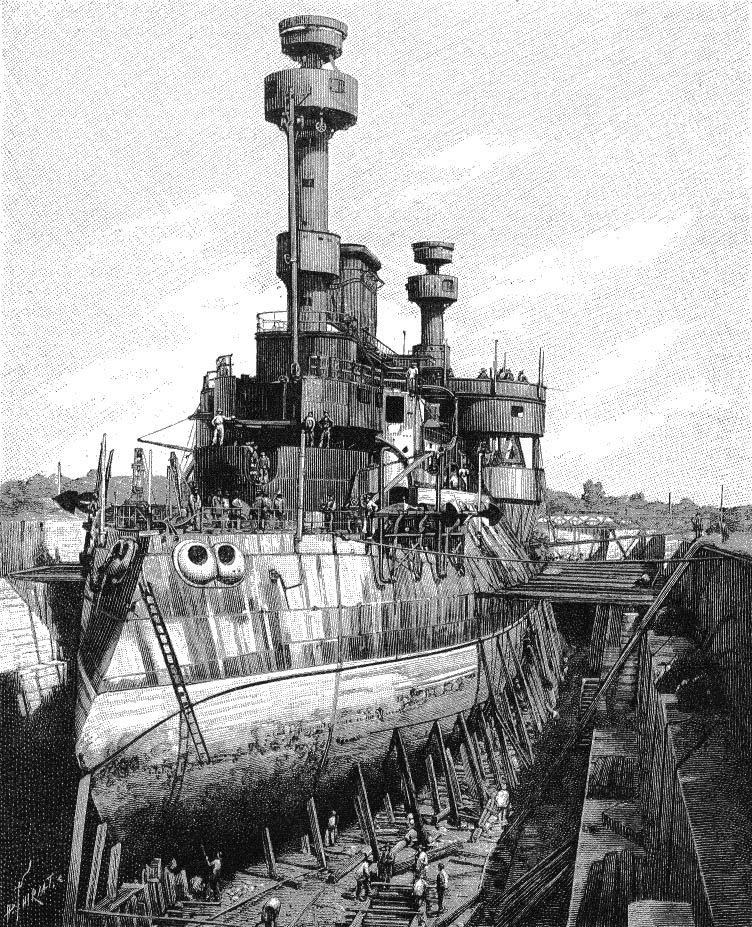
Hoche by Paul Thiriat
The turrets for the main guns had 320 mm walls and the barbettes protecting the turning mechanisms were 350 mm thick. The 274 mm guns barbettes were also 350 mm thick. They stood on the main deck but there was an unprotected vertical section down the armored deck, reduced in theory by the low and sloped freeboard height. It was calculated that the slope offered some extra protection above the waterline, and the water itself, at the level of the belt.
Propulsion of the Hoche
The Hoche powerplant consisted in two steam engines rated for 11,000 hp. Top speed as a result, with forced heating, reached 16 knots, as shown on trials. On paper this was 15 knots, with at normal output this fell to 12.5 knots. As her active life shown, her great instability led to further reduce this speed, especially for manoeuvring tightly.
The ship has a turning radius of around 400 meters and she was relatively agile and manoeuvrable due to her short hull and large breadth. Stability was good as long as she stayed in straight line. However, on trials, her structural overload quickly shown disturbing roll when turning at maximum speed. It reached 15 degrees.
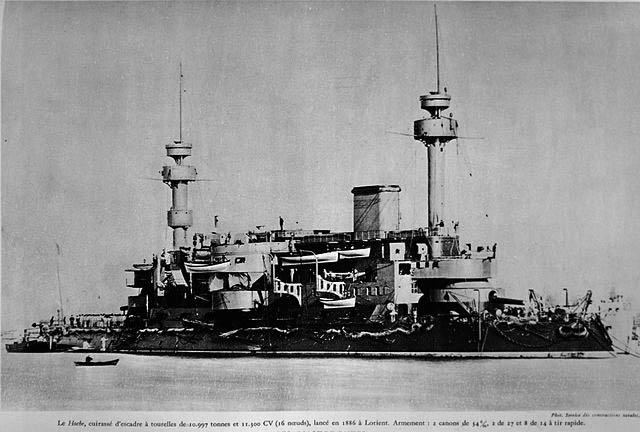
Hoche’s crew consisted of 611 officers and men. To carry them all, adnd land a Marine Infantry party as common for the time, the battleship was given no less than 15 boats suspended along the main galley. On each side initially were fitted two small spar torpedo boats for special operations, like attacking ships at anchor and minelaying. The Hoche, as customary in 1890, was given a provision of heavy netting and spars to create a wearable all-around protection at anchor.
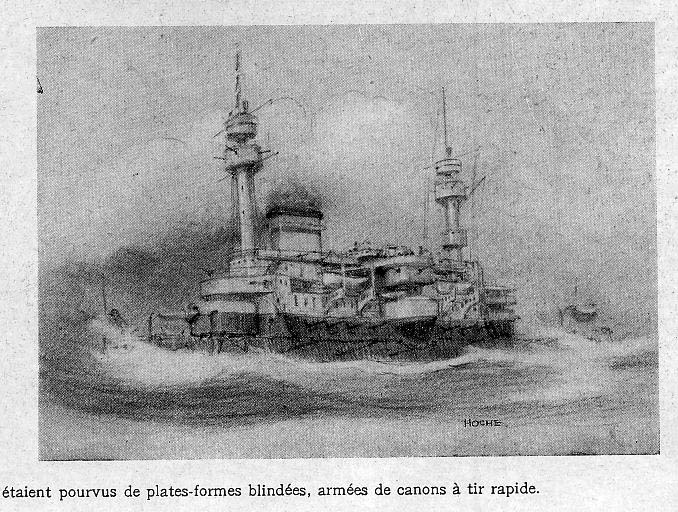
Career of the Hoche
Hoche went into operation in 1890. Soon, numerous problems started to emerge. She rolled badly as the wind itself was sufficient to push on the large area of the superstructure, keeping the guns for stabilizing. Also the hull was overweight so much that she plunged down in heavy weather – in fact both the bow and stern decks were excessively wet. Water would enter the fore and aft turrets, causing problems to the guns loaders and servants whereas salt corroded everything. Her bow plunged so badly that the bow wave seemed to flow permanently directly above, making her look like she was about to sink by the prow.
Nevertheless, the Hoche filled the French admiralty with pride, enough to send her with the innovative armored cruiser Dupuy de Lome to represent France at the inauguration of the Kiel Canal in 1895. The Kaiser then famously said (as was reported) “What a great target!”. By that time the only significant modifications has been the replacement of the old model 5.5-inch guns by new QF models 5.5-inch guns, twelve instead of eighteen, but in the same broadside battery.
Four were concerned plus two mounted in casemates on each corner while the aft military mast was replaced by a pole. At the same naval yard, this first modernization consisted in urgent work to lighten the superstructure and reducing the excessive metacentric height. But dismantling just one combat military mast was not enough. The extensive bridges and superstructures had to be dismantled, whereas the rounded protrusion hanging over the stern tower for the main caliber was to be removed.
Hoche emerged emerged with a different profile, but still this was not enough. As she returned in action, her stability proved to be still a concern. In 1892 as she served in the Mediterranean, near Marseilles, she collided with the liner Maréchal Canrobert, due to a navigation error of the latter while the second has her view obscured by smoke after firing her main guns. The steamer has been built in Scotland, in service since 1881, as a 1200-ton 250-foot iron-hull ship carrying mail and passengers for her new company operating between the colonies and France.
The fleet was indeed performing live fire and fast manoeuvers, and the liner, which came from Bône in North Africa, approached to offer her passengers a better view (according to testimonies and the enquiry), but came way too close and she was rammed and as a result cut in half, sinking very rapidly with the loss of 107 passengers. The Hoche remained mostly intact due to the strength of her ram bow, but immediately assisted passengers.
In 1897, Hoche was maneuvered into the dry dock at Brest for repairs by a tug, which captain made a misjudgment, letting the hull hitting the the angle of the dry dock. This added two months of extra work to repair the damage. On May 13, 1898 when she was steaming off the Quiberon Bay, Hoche ran into an uncharted rock, and had to returned to Brest for extra repairs. By July 1898 this translated into a full rebuilt.
She entered the drydock for a last time.
The foremast was now lowered and the hinged deck above the superstructures was removed, this time greatly reducing its height and weight. The Boilers were all replaced with new models, sixteen Belleville boilers, while the outdated secondary battery, twelve brand new 140 mm quick-firing guns were installed. Also her single large stack funnel was replaced by two smaller side-by-side stacks.
Nevertheless in 1899 she appeared totally out of fashion and her active life was drawing to an end. After 18 years of service and with the Dreadnought setting up a new breed, the Hoche had no military value left. In April 1908 she was decommissioned and placed in reserve. On January 1, 1910 she was disarmed. She ended sunk as target in November 1913, disarmed. She was sank by the French battleship Jauréguiberry and the armoured cruiser Pothuau on 2 December 1913 and therefore missed the great war.
Legacy
Being a revolutionary design Hoche was more advanced than its predecessors. The freeboard height reduction allowed to reduce the vulnerable area to shells and the new rhomboidal artillery arrangement made it possible to concentrate 3/4 of the main guns in any direction. In addition these 340 mm armored towers on thick barbettes offered many advantages. Both heavy military masts were also looked upon as an improvements and found many uses. But all this was paid dearly.
Hoche’s Achille heal was her very low stability. Her captains soon learned to avoid turning at full speed, as she systematically tilted to 15 degrees, bordering with the no-limit (recovery) point. This was caused by excessively heavy superstructures, bulky combat masts, and highly placed artillery. All this was the result of political interference and constant revisions. The Hoche was in short an overloaded mess, which new, taller belt armour ended totally hidden underwater, defeating her purpose in the first place.
Despite all this, the admiralty was pleased with the ship, abundantly showcased in the press and a proof of French ingenuity. She looked, and was a powerful ship due to her considerable artillery to the point of being considered very successful. The rhomboidal artillery pattern was repeated in subsequent battleships designs and many other French warships, until twin turrets were at last adopted.
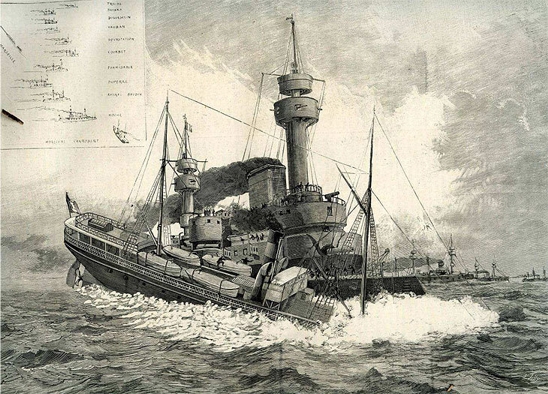
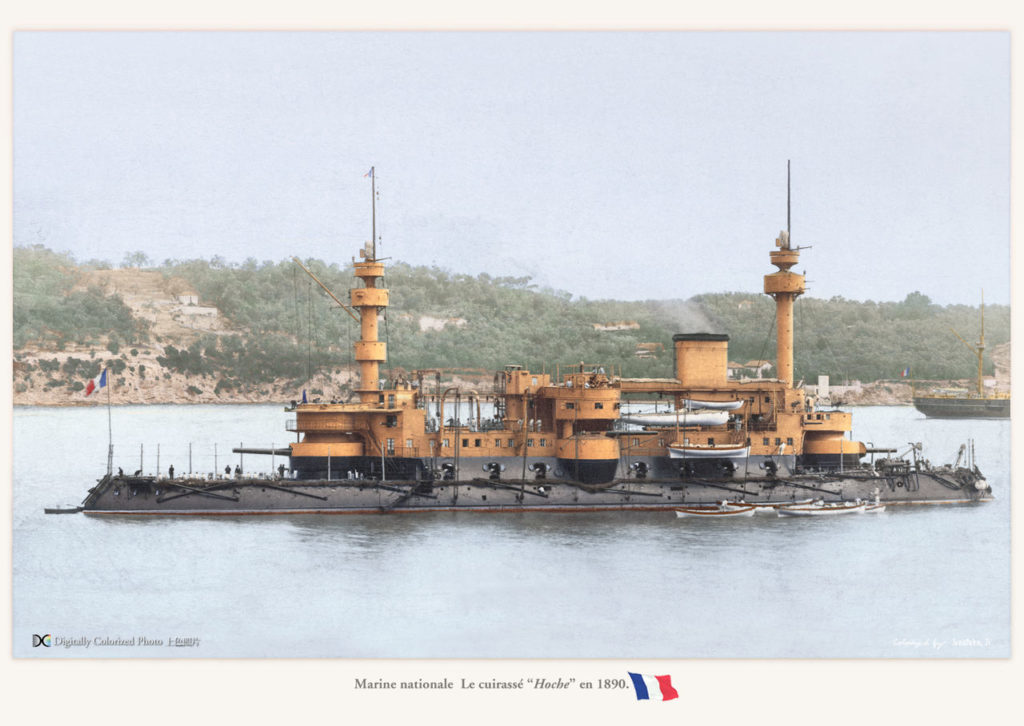
Hoche at VilleFranche circa 1890 – Colorized by Irootoko Jr.
Henri IV class specifications |
|
| Dimensions | 102,59 m x 20,22 m x 8,31 m |
| Displacement | 10 820 tjb |
| Crew | 26 officers 438 sailors |
| Propulsion | 2 shaft HTE, 8 Niclausse boilers, 12,000 hp. |
| Speed | 16.5 knots. max. (30 km/h; 19 mph) |
| Range | ? nmi (740 tonnes coal) |
| Armament | 2 x 340 mm, 2 x 274 mm, 18 x 138 mm, 10 x 47 mm, 5 x 37 mm, 5 380 mm TTs |
| Armor | Belt 460 mm, barbettes 400 mm, decks 80 mm, turret 400 mm |
Read More
J. Gardiner Conway’s all the world’s fighting ships 1865-1905
-Jean Meyer et Martine Acerra, Histoire de la marine française des origines à nos jours
-Rémi Monaque, Une histoire de la marine de guerre française
-Michel Vergé-Franceschi, Dictionnaire d’Histoire maritime
-Geoffrey Regan’s Book of Naval Blunders. André Deutsch. pp. 43–44
-Alain Boulaire, La Marine française : De la Royale de Richelieu aux missions d’aujourd’hui
-Jean-Michel Roche, Dictionnaire des bâtiments de la flotte de guerre française de Colbert à nos jours, t. 1 1671-1870
alchetron.com/French-battleship-Henri-IV
Official Yard museum model
https://www.battleships-cruisers.co.uk/hoche.htm
‘Cent ans de Cuirasse Francais’ Eric Gille
Warships fotofax French battleships 1876-1946 R.A. Burt
Musée de la Marine, Paris
//dawlishchronicles.com/2017/05/30/hoche-marechal-canrobert-collision-1892/
//fr.wikipedia.org/wiki/Hoche_(cuirass%C3%A9)
//www.laroyale-modelisme.net/t16644-les-cuirasses-dans-tout-leur-etat
Postcard
dreadnoughtproject.org/French%20Warship%20Plans/Hoche
http://www.steelnavy.com/Combrig350Hoche.htm
The Model corner
Kombrig 1/700 Hoche
Kombrig 1/350 Hoche Resin
Review of the Kombrig model

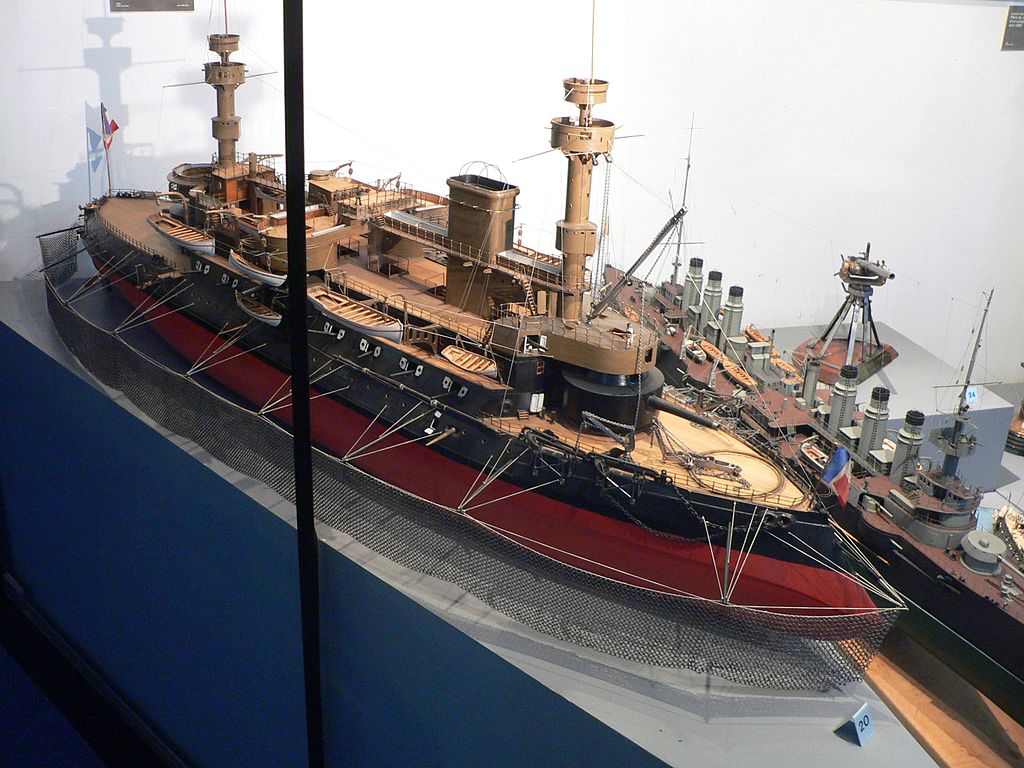
 Latest Facebook Entry -
Latest Facebook Entry -  X(Tweeter) Naval Encyclopedia's deck archive
X(Tweeter) Naval Encyclopedia's deck archive Instagram (@navalencyc)
Instagram (@navalencyc)





 French Navy
French Navy Royal Navy
Royal Navy Russian Navy
Russian Navy Armada Espanola
Armada Espanola Austrian Navy
Austrian Navy K.u.K. Kriegsmarine
K.u.K. Kriegsmarine Dansk Marine
Dansk Marine Nautiko Hellenon
Nautiko Hellenon Koninklije Marine 1870
Koninklije Marine 1870 Marinha do Brasil
Marinha do Brasil Osmanlı Donanması
Osmanlı Donanması Marina Do Peru
Marina Do Peru Marinha do Portugal
Marinha do Portugal Regia Marina 1870
Regia Marina 1870 Nihhon Kaigun 1870
Nihhon Kaigun 1870 Preußische Marine 1870
Preußische Marine 1870 Russkiy Flot 1870
Russkiy Flot 1870 Svenska marinen
Svenska marinen Søværnet
Søværnet Union Navy
Union Navy Confederate Navy
Confederate Navy Armada de Argentina
Armada de Argentina Imperial Chinese Navy
Imperial Chinese Navy Marinha do Portugal
Marinha do Portugal Mexico
Mexico Kaiserliche Marine
Kaiserliche Marine 1898 US Navy
1898 US Navy Sovietskiy Flot
Sovietskiy Flot Royal Canadian Navy
Royal Canadian Navy Royal Australian Navy
Royal Australian Navy RNZN Fleet
RNZN Fleet Chinese Navy 1937
Chinese Navy 1937 Kriegsmarine
Kriegsmarine Chilean Navy
Chilean Navy Danish Navy
Danish Navy Finnish Navy
Finnish Navy Hellenic Navy
Hellenic Navy Polish Navy
Polish Navy Romanian Navy
Romanian Navy Turkish Navy
Turkish Navy Royal Yugoslav Navy
Royal Yugoslav Navy Royal Thai Navy
Royal Thai Navy Minor Navies
Minor Navies Albania
Albania Austria
Austria Belgium
Belgium Columbia
Columbia Costa Rica
Costa Rica Cuba
Cuba Czechoslovakia
Czechoslovakia Dominican Republic
Dominican Republic Haiti
Haiti Hungary
Hungary Honduras
Honduras Estonia
Estonia Iceland
Iceland Eire
Eire Equador
Equador Iran
Iran Iraq
Iraq Latvia
Latvia Liberia
Liberia Lithuania
Lithuania Mandchukuo
Mandchukuo Morocco
Morocco Nicaragua
Nicaragua Persia
Persia San Salvador
San Salvador Sarawak
Sarawak Uruguay
Uruguay Venezuela
Venezuela Zanzibar
Zanzibar Warsaw Pact Navies
Warsaw Pact Navies Bulgaria
Bulgaria Hungary
Hungary

 Bundesmarine
Bundesmarine Dutch Navy
Dutch Navy Hellenic Navy
Hellenic Navy Marina Militare
Marina Militare Yugoslav Navy
Yugoslav Navy Chinese Navy
Chinese Navy Indian Navy
Indian Navy Indonesian Navy
Indonesian Navy JMSDF
JMSDF North Korean Navy
North Korean Navy Pakistani Navy
Pakistani Navy Philippines Navy
Philippines Navy ROKN
ROKN Rep. of Singapore Navy
Rep. of Singapore Navy Taiwanese Navy
Taiwanese Navy IDF Navy
IDF Navy Saudi Navy
Saudi Navy Royal New Zealand Navy
Royal New Zealand Navy Egyptian Navy
Egyptian Navy South African Navy
South African Navy






























 Ukrainian Navy
Ukrainian Navy dbodesign
dbodesign